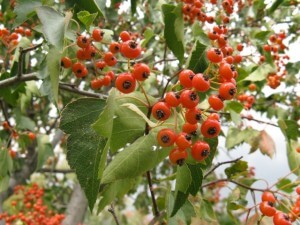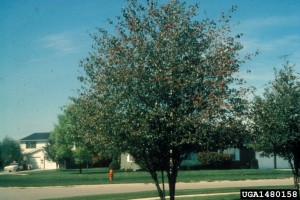
Washington hawthorn tree (Crataegus phaenopyrum) is a common ornamental landscape tree in the Eastern and Central United States. The genus Crataegus is a large genus including many species referred to as hawthorn tree, hawthorn apple thornapple, maytree, whitethorn and hawberry. Although this article focuses on the washington hawthorn tree the information here applies to many other species in the genus. Washington hawthorn tree is native to the US and serves as an important food source for wildlife such as squirrels and birds. The culinary and medicinal use of plants in the hawthorn genus: Crataegus goes back thousands of years to many people and cultures around the globe. This plant has a long history of use by humans.
Hawthorn Fruit
Hawthorn fruit is edible and delicious. The seeds are likely about as poisonous as apple seeds, see the ‘cautions’ section below. The washington hawthorn tree has small berries grouped into clusters. Even this species with its small berries is worth finding. I usually take a mouthful of hawthorn fruit and spit out the seeds. There are other species with larger berries as well but this particular species is very common in the Norhteastern US, therefore it is easy to find and forage. Hawthorn fruits are produced in the fall and hang on into mid winter. Hawthorn fruit can be used as a flavoring or addition to many things. Click Here to learn how to make a Hawthorn extract.
Health Benefits
Hawthorn berries, young leaves and fresh hawthorn flowers are known to lower blood pressure and have a general tonic effect on the heart. There are numerous hawthorn products that focus on cardiovascular health on the market. This is one of the primary traditional medicinal uses of Hawthorn throughout the world. Combining hawthorn with Hibiscus is one way to reap the heart and blood pressure benefits of both plants.
Cautions
Hawthorns are in the same subfamily as apples and likely have poisonous seeds like apples. At least one report says that the seeds are significantly poisonous and too many could be lethal to children, other reports don’t mention it. Exercise caution and spit out the seeds. Hawthorns have been used safely by humans for thousands of years. Another thing to watch out for when harvesting is THORNS! They are sharp and long!
Key ID Features

Identifying a plant as being definitively in the genus: Crataegus is difficult. There are some typical features but not all species show them and not all features distinguish them from other plants. There are a few general identification features. 1) They have thorns which can be very long (up to 4″). 2) they typically have lobed or largely serrated leaf margins. 3) The fruits of all species are pomes(apple-like) but might be difficult to determine as such since the seeds in the middle sometimes stick together. As well as all the ID features above there are some identification features that are particular to Washington Hawthorn that will help with identifying this plant. The leaf shape tends to be shallowly to deeply lobed as well as serrated and pyramidal. The berries grow in clusters in the fall and winter and are small and red with a dark circular ‘crown’ at the end of the berry. So if you have found a plant that has thorns, fall pomes, and serrated leaves, it is likely a hawthorn, the best next step would be to research hawthorns in your area and compare to make a positive ID.
Conclusion
Hawthorn is a delicious cultivated and wild edible fruit for many parts of the world. In the eastern US washington hawthorn is a very common native species, promoting and growing this plant is great for human and animal foragers. There are some important health benefits to be had as well, especially in regards to heart health which is one of the leading health problems among Americans. Add Hawthorn to your diet for a healthy tasty winter snack.
Many of our readers find that subscribing to Eat The Planet is the best way to make sure they don't miss any of our valuable information about wild edibles.
See our privacy policy for more information about ads on this site







8 Responses
is the berries poisonous to dwarf hamsters? mine ate one and i don’t want her to die
What did you find out?
Thanks for this.
ExcellentThanks
I’m wondering about the thornless variety of Hawthorne, I’m aiming to make a tincture for high blood pressure and picked a bunch from my neighbors tree, it’s not large and doesn’t have the thorns. Are the berries still good for medicine?
awaiting a reply on this!
I wished you would show close up pictures of the leaves, seeds, fruits, borders of the leaves and every single detail you just mention. You are teaching here and nothing compares to seeing what you just describe with words.
It is quite frustrating, as it is the complete lack of answers to all the questions posed.
It doesn’t look like the author reads these questions and comments.